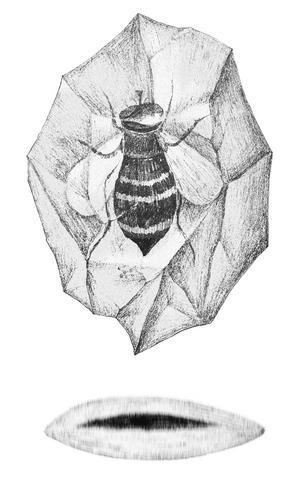Flies have been around for at least 250 million years, surviving global warming and freezing and major "extinction events" such as that which wiped out the dinosaurs. Yet we know surprisingly little about this constant and frequently irritating companion to man and animal life.
In an attempt to rectify this, Australian scientists have joined a global effort to map the genetic structure and evolutionary history of the fly which could also entail a major rethink of Darwinian principles. One of them, David Yeates, an entomologist, describes the task as "an incredibly important project considering flies comprise about 10 percent of animal life forms on the planet."
Yeates and John Oakshott, a molecular biologist, are directing a US$2.4 million grant from America's National Science Foundation for Australian participation in the study, which also includes US, Canadian and Singaporean teams. Their job is to bring together field research in the coming fly-ridden Australian summer and recover the fossil records going back millions of years of flies preserved in amber, shale and ancient layers of marine sediments.

ILLUSTRATION: MOUNTAIN PEOPLE
"It is difficult but not impossible to recover data from flies that have been dead for a few hundred million years," Yeates says.
"In some cases, they left behind hard casings or exo-skeletal remains, and in others we even see internal organs containing traces of DNA. With very well preserved flies or those we catch alive, electron microscopy is yielding detail that would have eluded scrutiny until recent advances in medical or forensic technology," he says.
A favorite saying of Yeates is that "a big part of biodiversity is actually `flyodiversity.' Of nearly 2 million living species known to science, and with many more yet to be identified, around one-tenth are flies or `diptera' of some sort," he adds.
Diptera, a large order of insects having a single pair of wings and a sucking or piercing mouthpart, includes flies, mosquitoes, gnats and midges.
Yeates estimates there are up to 40,000 distinct species of flies in Australia alone, although only 8,000 of them have been scientifically described and named. When the five-year international project is completed it expects to have grouped between 200,000 to 400,000 types of flies into at least 150 distinct families.
"There are major practical implications from knowing our flies better," Yeates says. "They have been around for at least 250 million years, appearing well before the dinosaurs and surviving periods of global warming, global freezing and major extinction events that saw many species, including the dinosaurs, cut down at the seeming height of their powers. So we know that by studying their genetic make-up we may learn more about their capacity to adapt to shocks that destroyed other life forms."
But the benefit of mapping fly DNA goes much further, because the fly genome has enough in common with the human genome to help decode the more complex genetic makeup of mankind. Being simpler, it is also much better understood in species like the common brown fly found everywhere except in the most extreme southern polar environments.
"When we see something unknown in the human genome we can often get clues to its purpose by computer matching a similar genetic structure in a type of fly where that particular molecular combination already has a known function," Yeates says.
Oakshott's major role in the project is to examine the genes that are making some modern flies resistant to the pesticides used in agriculture. Finding out whether those genes have lain dormant for aeons before being "turned on" by a dose of fly spray, or evolved as an instantaneous defense mechanism in flies in the last 100 years is one of the biggest riddles in the study of evolution.
"This is a crucial question because it is asked of all species of animal," Yeates says. "If we discover that the environmental stresses caused by the rise of humans can cause the instantaneous origination of new species of flies then a lot of things that are accepted about evolution will need revision."
Already the world's farms -- where pesticide-resistant flies are breeding better than those that didn't adapt -- are looking like a case study from journals of the 19th century naturalist Charles Darwin, who first described the evolution of species as a coherent scientific theory.
The Australian part of the fly study will be incorporated in a National Science Foundation "Tree of Life" electronic databank and a web site run by the US Department of Agriculture in Washington.
"This is where the continuing practical benefits of the work will become apparent," Yeates says. "It means there will be an open source of information available for use by agricultural or medical researchers, where the answers to their questions may have been buzzing around their heads without being recognized."

China has not been a top-tier issue for much of the second Trump administration. Instead, Trump has focused considerable energy on Ukraine, Israel, Iran, and defending America’s borders. At home, Trump has been busy passing an overhaul to America’s tax system, deporting unlawful immigrants, and targeting his political enemies. More recently, he has been consumed by the fallout of a political scandal involving his past relationship with a disgraced sex offender. When the administration has focused on China, there has not been a consistent throughline in its approach or its public statements. This lack of overarching narrative likely reflects a combination
Father’s Day, as celebrated around the world, has its roots in the early 20th century US. In 1910, the state of Washington marked the world’s first official Father’s Day. Later, in 1972, then-US president Richard Nixon signed a proclamation establishing the third Sunday of June as a national holiday honoring fathers. Many countries have since followed suit, adopting the same date. In Taiwan, the celebration takes a different form — both in timing and meaning. Taiwan’s Father’s Day falls on Aug. 8, a date chosen not for historical events, but for the beauty of language. In Mandarin, “eight eight” is pronounced
US President Donald Trump’s alleged request that Taiwanese President William Lai (賴清德) not stop in New York while traveling to three of Taiwan’s diplomatic allies, after his administration also rescheduled a visit to Washington by the minister of national defense, sets an unwise precedent and risks locking the US into a trajectory of either direct conflict with the People’s Republic of China (PRC) or capitulation to it over Taiwan. Taiwanese authorities have said that no plans to request a stopover in the US had been submitted to Washington, but Trump shared a direct call with Chinese President Xi Jinping (習近平)
It is difficult to think of an issue that has monopolized political commentary as intensely as the recall movement and the autopsy of the July 26 failures. These commentaries have come from diverse sources within Taiwan and abroad, from local Taiwanese members of the public and academics, foreign academics resident in Taiwan, and overseas Taiwanese working in US universities. There is a lack of consensus that Taiwan’s democracy is either dying in ashes or has become a phoenix rising from the ashes, nurtured into existence by civic groups and rational voters. There are narratives of extreme polarization and an alarming